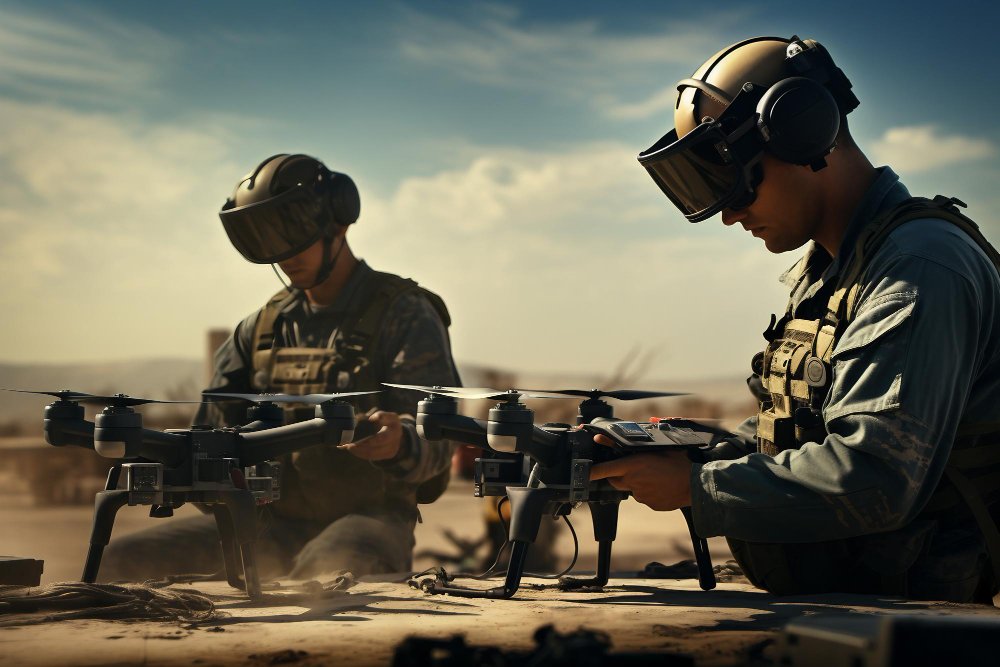2024's Top 5 Military Innovations Shaping Defense Industry
The contemporary landscape of military engagements is undergoing a transformative phase, propelled by the relentless pace of technological innovation. Virtual training environments, instantaneous equipment production capabilities, and robust data encryption measures have transcended the world of speculative fiction. These advancements represent the new paradigm of defense innovation, where cutting-edge technologies revolutionize the manner in which military forces hone their skills, conduct operations, and safeguard sensitive information.
Immersive Technologies Redefine Training And Combat
Immersive technologies like virtual reality (VR) and augmented reality (AR) are reshaping the landscape of defense training and operational preparedness. VR enables the creation of highly realistic simulations for combat and other critical scenarios, providing a safe and cost-effective environment for soldiers to hone their skills. Meanwhile, AR enhances real-world situational awareness by overlaying crucial information such as maps, enemy positions, and friendly forces directly onto the soldier's field of vision, facilitating quicker and more informed decision-making. Additionally, both technologies contribute to effective mission planning by generating detailed 3D terrain models and simulating potential scenarios, enabling commanders to strategize and assess risk more comprehensively. The integration of VR and AR into defense protocols marks a significant leap forward in training methodologies, ultimately contributing to a more efficient and adaptable fighting force.
A new initiative uses commercial VR headsets and custom software for immersive military training. High frame rates and large virtual environments offer realistic training scenarios for firearms and combat skills.
A defense innovator is creating an airborne AR system that uses AI to blend virtual enemies into real training for pilots and ground crews. This adaptable tech boosts combat readiness in various scenarios.
Revolutionizing Defense With Additive Manufacturing
3D printing is transforming the defense industry by enabling the creation of lighter, more efficient equipment. This innovative technology uses additive manufacturing to produce parts with less material, reducing weight and enhancing performance in areas like speed, capacity, and fuel consumption. Additionally, 3D printing allows for on-demand production closer to the point of need, streamlining logistics. The technology also opens up new possibilities for designing innovative solutions like advanced armor, self-heating clothing, and specialized ammunition.
Mobile production systems, like micro-factories and 3D printers, allow on-site manufacturing of military parts and equipment in remote areas. This reduces supply chain dependence, improves operational resilience, and ensures access to critical resources in challenging environments.
Microwave-assisted deposition (MAD) 3D printing revolutionizes aerospace component manufacturing. This process rapidly produces large-scale, lightweight thermoset and ceramic matrix composites using standard materials, offering cost, time, and design advantages.
Unlocking Strategic Advantage With Quantum Computing And AI
In the modern defense landscape, the strategic advantage lies in harnessing the power of data. Big data analytics, combined with emerging technologies like quantum computing, enables military forces to gain critical insights from diverse sources, enhancing decision-making capabilities. Efficient data interpretation from the Internet of Military Things (IoMT) further strengthens situational awareness. Predictive analytics plays a crucial role in not only deterring threats but also optimizing safety and efficiency in high-risk operations. By anticipating potential threats, defense strategies can be proactively tailored for enhanced preparedness and response.
Cloud-based quantum computing software is enhancing defense through applications like cryptographic analysis, threat detection, and precise navigation.
Deep reinforcement learning is being used to automate complex defense tasks, particularly those involving multiple actors. This technology enables autonomous vehicle maneuvering and improves information sharing for enhanced operational effectiveness.
Empowering The Future Of Defense Operations And Connectivity With 5G
5G technology is revolutionizing defense operations by enabling real-time decision-making and enhancing situational awareness. Its high-speed, secure connectivity empowers innovative command-and-control applications and optimizes logistics. Additionally, 5G facilitates the creation of robust battlefield networks by enabling seamless communication between remote sensors, weapons, and unmanned systems like drones and autonomous vehicles. This interconnectedness enhances training capabilities and improves operational effectiveness in the field.
Private 5G infrastructure is accelerating digital transformation for defense organizations. This open, flexible system uses standard hardware and supports innovative applications like edge computing.
A new wireless charging tech is set to transform power management for defense. It creates a mesh network to deliver energy over the air, eliminating the need for batteries on IoMT devices and ensuring continuous operation. It uses existing protocols like 5G or Wifi for device coordination.
Blockchain Bolstered Defense
Blockchain technology is emerging as a key tool for enhancing data security within the defense sector. By providing a decentralized and immutable ledger, blockchain safeguards sensitive military information and strengthens defenses against cyberattacks. This technology finds applications in various areas, from tracking military assets and streamlining procurement processes to securing supply chains and ensuring fair dealings with defense contractors. Additionally, blockchain-based voting systems are bolstering the integrity of internal elections and surveys within military organizations.
Blockchain technology is revolutionizing defense data security with its tamper-proof, distributed ledger system. This approach offers secure storage and facilitates forensic investigations after cyberattacks.
Combining blockchain, data analytics, and AI, an innovative solution is transforming process management in defense and aerospace. This system automates supply chain and maintenance, ensuring transparency and optimizing resource allocation.
Partner With Choctaw Global For A Stronger Defense Future
Choctaw Global isn't just a defense contractor, it's a legacy of innovation and collaboration. Rooted in the Choctaw spirit, we leverage diverse expertise across industries to deliver comprehensive defense solutions. Our commitment to excellence and adaptability ensures our partners are equipped for the ever-changing defense landscape. Join us in building a secure future, where cutting-edge technology meets time-honored values. Connect with our team today and explore how we can empower defense initiatives.

